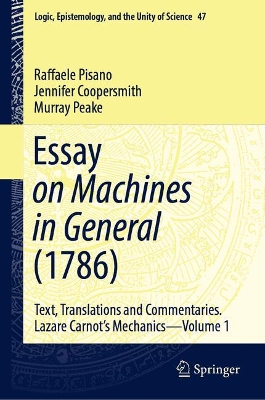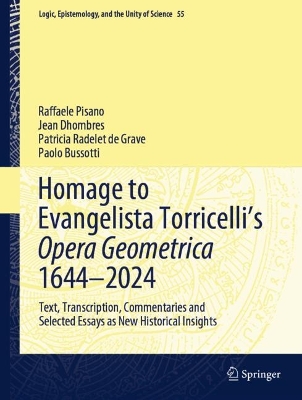Logic, Epistemology, and the Unity of Science
3 primary works
Book 47
Essay on Machines in General (1786)
by Raffaele Pisano, Jennifer Coopersmith, and Murray Peake
This book offers insights relevant to modern history and epistemology of physics,
mathematics and, indeed, to all the sciences and engineering disciplines emerging
of 19th century. This research volume is the first of a set of three Springer books on
Lazare Nicolas Marguerite Carnot's (1753-1823) remarkable work: Essay on Machines in
General (Essai sur les machines en general [1783] 1786). The other two forthcoming
volumes are: Principes fondamentaux de l'equilibre et du mouvement (1803) and
Geometrie de position (1803).
Lazare Carnot - l'organisateur de la victoire - in Essai sur le machine en general (1786)
assumed that the generalization of machines was a necessity for society and its economicdevelopment. Subsequently, his new coming science applied to machines attracted
considerable interest for technician, as well, already in the 1780's. With no lack in
rigour, Carnot used geometric and trigonometric rather than algebraic arguments, and
usually went on to explain in words what the formulae contained. His main physical-
mathematical concepts were the Geometric motion and Moment of activity-concept of
Work . In particular, he found the invariants of the transmission of motion (by stating
the principle of the moment of the quantity of motion) and theorized the condition of
the maximum efficiency of mechanical machines (i.e., principle of continuity in thetransmission of power).
While the core theme remains the theories and historical studies of the text, the book
contains an extensive Introduction and an accurate critical English Translation -
including the parallel text edition and substantive critical/explicative notes - of Essai
sur les machines en general (1786). The authors offer much-needed insight into the
relation between mechanics, mathematics and engineering from a conceptual, empirical
and methodological, and universalis point of view. As a cutting-edge writing by
leading authorities on the history of physics and mathematics, and epistemological
aspects, it appeals to historians, epistemologist-philosophers and scientists (physicists,
mathematicians and applied sciences and technology).
Book 55
Homage to Evangelista Torricelli’s Opera Geometrica 1644–2022
by Raffaele Pisano, Jean Dhombres, Patricia Radelet De Grave, and Paolo Bussotti
Evangelista Torricelli exemplifies the use the moderns made of the ancients' mathematical methods. Celebrating Evangelista Torricelli's monumental Opera geometrica, this book marks 378 years since its publication (1644-2022). This homage to Torricelli introduces the magnificent major work in Mechanics and Mathematics of a brilliant Archimedean–and–Galilean scientist to modern readers.
Opera geometrica deals with Motion & Mechanics and Geometry & Infinitesimals. In quibus Archimedis doctrina Torricelli also presents his mechanical principle of equilibrium – the foundation of the modern Principle of Virtual Work/Static.
This outstanding source and research book spotlights the relevance and originality of Torricelli’s Mechanics, and is the first and most profound analysis of the Opera geometrica to date. The historical study is achieved in extensive Introduction, 5 Essays and an accurate Transcription of Opera geometrica with parallel side–by–side text, including substantive explicative notes. The book is an accessible avenue to understanding this work by leading authorities who offer much-needed insights into the relationship Physics–Mathematics, Mechanics and Fundamentals. It appeals to historians, epistemologist and scientists.
Book 56
Cosmology in the Early Modern Age: A Web of Ideas
by Paolo Bussotti and Brunello Lotti
This volume addresses the history and epistemology of early modern cosmology. The authors reconstruct the development of cosmological ideas in the age of ‘scientific revolution’ from Copernicus to Leibniz, taking into account the growth of a unified celestial-and-terrestrial mechanics. The volume investigates how, in the rise of the new science, cosmology displayed deep and multifaceted interrelations between scientific notions (stemming from mechanics, mathematics, geometry, astronomy) and philosophical concepts. These were employed to frame a general picture of the universe, as well as to criticize and interpret scientific notions and observational data.
This interdisciplinary work reconstructs a conceptual web pervaded by various intellectual attitudes and drives. It presents an historical–epistemological unified itinerary which includes Copernicus, Kepler, Galileo, Descartes, Huygens, Newton and Leibniz. For each of the scientists and philosophers, a presentation and commentary is made of their cosmological views, and where relevant, outlines of their most relevant physical concepts are given. Furthermore, the authors highlight the philosophical and epistemological implications of their scientific works. This work is helpful both as a synthetic overview of early modern cosmology, and an analytical exposition of the elements that were intertwined in early-modern cosmology. This book addresses historians, philosophers, and scientists and can also be used as a research source book by post-graduate students in epistemology, history of science and history of philosophy.


